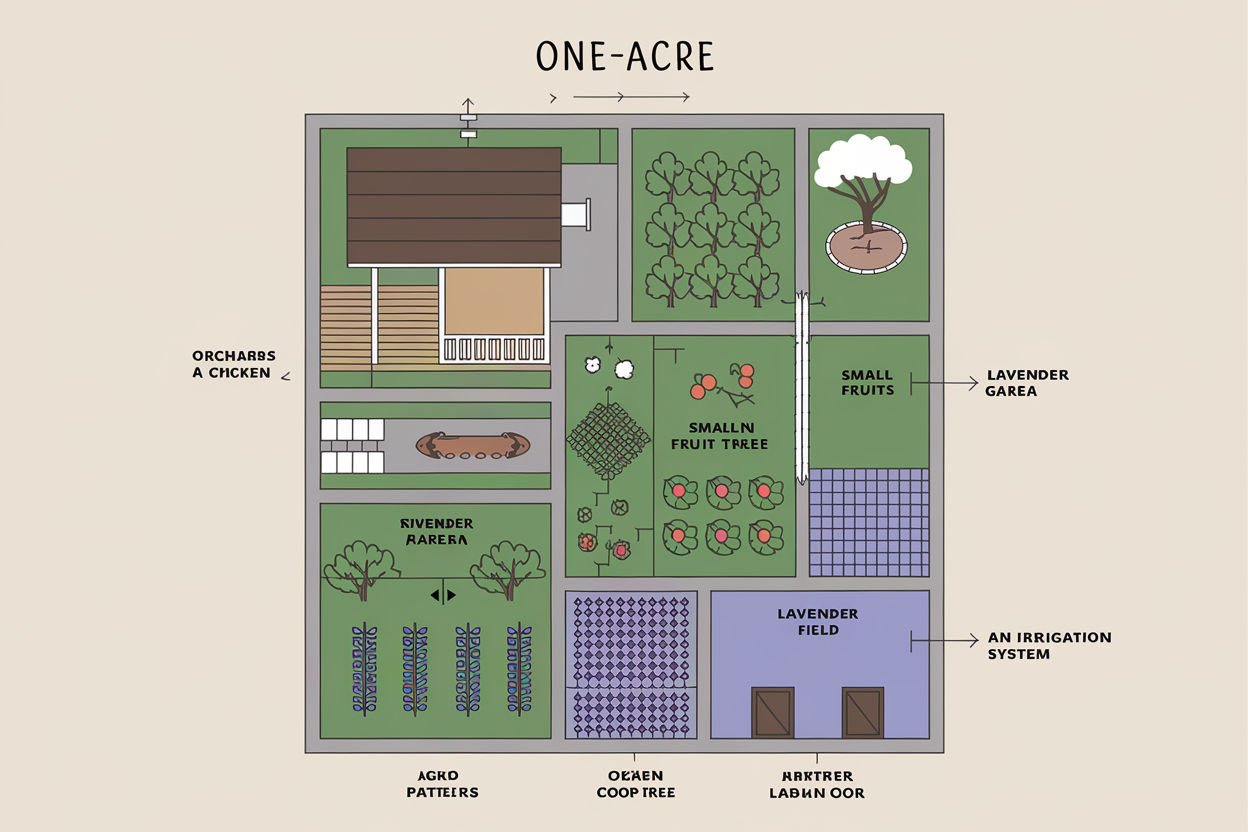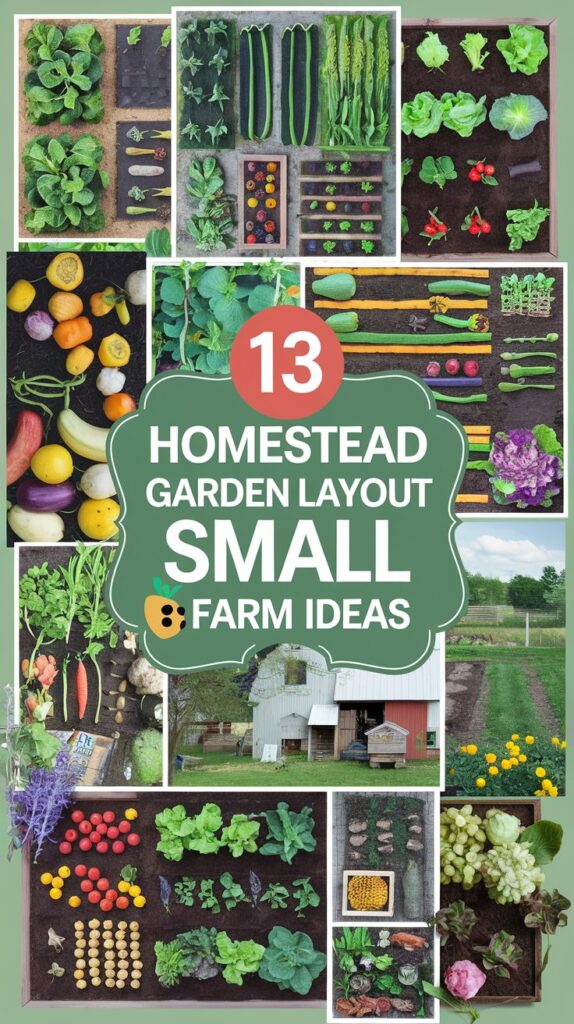13 Homestead Garden Layout Small Farm Ideas

13 Homestead Garden Layout Small Farm Ideas
Creating a productive and efficient homestead garden layout is essential for maximizing space and ensuring sustainable farming practices.
Whether you’re working with a small backyard or a larger plot of land, thoughtful planning can help you achieve a fruitful garden.
Here are 13 homestead garden layout ideas for small farms that cater to various needs, aesthetics, and climates.
1. Raised Bed Garden
Raised beds are an excellent choice for small farms as they allow for better soil management and drainage. This layout maximizes space and provides easier access for planting, weeding, and harvesting.
- Design Tips: Construct beds in a rectangular or square shape, leaving paths between them for easy access. Use materials like wood, stone, or recycled materials. A height of 12 to 24 inches is ideal for most plants.
- Planting Suggestions: Consider growing a mix of vegetables, herbs, and flowers in each bed. Companion planting can also help improve yields and deter pests.
2. Permaculture Garden
💥🎁 Christmas & Year-End Deals On Amazon !
Don't miss out on the best discounts and top-rated products available right now!
🛒 Shop Now and Save Big Today!*As an Amazon Associate, I earn from qualifying purchases.
Permaculture is a sustainable design approach that mimics natural ecosystems. This layout focuses on creating a self-sufficient garden that requires minimal input.
- Design Tips: Divide your garden into zones based on usage. For example, place frequently accessed plants (like herbs and salad greens) near your home and more extensive crops further away.
- Planting Suggestions: Incorporate perennials, fruit trees, and legumes, which can fix nitrogen in the soil. Use guilds, where plants support one another (e.g., planting nitrogen-fixing clover with fruit trees).
3. Vertical Garden
Vertical gardening is perfect for small spaces and can add aesthetic appeal to your homestead. It utilizes vertical structures to grow plants upwards instead of outwards.
- Design Tips: Use trellises, wall planters, or hanging pots to create vertical space. Consider integrating vertical gardening with raised beds to optimize land use.
- Planting Suggestions: Ideal plants include climbing beans, peas, cucumbers, and strawberries. You can also grow herbs like basil and thyme in wall planters.
4. Square Foot Gardening
This method divides the garden into small square plots, making it easy to plan and maintain. It maximizes production in a limited area and encourages intensive planting.
- Design Tips: Create a grid layout, with each square foot designated for a different type of plant. This method also reduces the space needed for pathways, allowing more room for crops.
- Planting Suggestions: Each square can accommodate different plants based on their size, such as four lettuce plants, nine radishes, or one tomato. This method encourages diversity.
5. Herb Spiral
An herb spiral is a vertical garden structure designed to maximize space while providing various microclimates for different herbs.
- Design Tips: Build a spiral-shaped raised bed with stones or bricks. The height creates various conditions; the top is drier and hotter, while the base is cooler and wetter.
- Planting Suggestions: Include culinary herbs like basil, rosemary, and thyme, alongside medicinal herbs such as chamomile and echinacea.
6. Companion Planting Layout
Companion planting involves placing plants together that benefit each other, enhancing growth and reducing pests.
- Design Tips: Research compatible plants and design your garden layout accordingly. Group plants that deter pests or attract beneficial insects together.
- Planting Suggestions: Common pairings include tomatoes with basil, carrots with onions, and corn with beans. This method promotes biodiversity and reduces the need for chemical inputs.
7. Keyhole Garden
💥🎁 Christmas & Year-End Deals On Amazon !
Don't miss out on the best discounts and top-rated products available right now!
🛒 Shop Now and Save Big Today!*As an Amazon Associate, I earn from qualifying purchases.
A keyhole garden is a circular garden bed with a composting area in the center. It’s efficient in water use and promotes healthy soil.
- Design Tips: Build a raised circular bed with a wedge-shaped path leading to the compost area. The compost will nourish the plants surrounding it.
- Planting Suggestions: Plant a variety of vegetables, herbs, and edible flowers in the surrounding beds. Use the compost center to continually enrich the soil.
8. Fruit Tree Guild
A fruit tree guild involves planting various species around a fruit tree to enhance its growth and health. This layout promotes biodiversity and helps with pest control.
- Design Tips: Create a circle around the base of the tree, planting complementary species that provide support and nutrients to the tree.
- Planting Suggestions: Include nitrogen-fixing plants (like clover), ground cover plants (like strawberries), and flowers that attract beneficial insects (like marigolds).
9. Three Sisters Garden
This traditional Native American planting method involves growing corn, beans, and squash together, leveraging their unique growth habits.
- Design Tips: Plant corn first, allowing it to grow tall. Once established, add beans that will climb the corn stalks. Finally, plant squash around the base to shade the ground and suppress weeds.
- Planting Suggestions: Use a variety of corn, beans, and squash to maximize harvest. This method improves yields and creates a symbiotic relationship between the plants.
10. Pollinator Garden
A pollinator garden focuses on attracting bees, butterflies, and other beneficial insects to improve pollination and biodiversity.
- Design Tips: Incorporate diverse flowering plants throughout your garden, choosing species that bloom at different times for continuous attraction.
- Planting Suggestions: Include native wildflowers, herbs like lavender and mint, and flowering vegetables like zucchini and tomatoes. Avoid using pesticides to protect pollinators.
11. Aquaponic Garden
Aquaponics combines aquaculture (raising fish) with hydroponics (growing plants without soil). This sustainable system creates a self-sustaining ecosystem.
- Design Tips: Design a layout that integrates a fish tank with grow beds above it, using a water pump to circulate water between the two.
- Planting Suggestions: Choose fast-growing plants like lettuce, herbs, and some vegetables. Tilapia or goldfish are common fish choices that thrive in aquaponic systems.
12. Row Gardening
💥🎁 Christmas & Year-End Deals On Amazon !
Don't miss out on the best discounts and top-rated products available right now!
🛒 Shop Now and Save Big Today!*As an Amazon Associate, I earn from qualifying purchases.
Row gardening is a straightforward and traditional approach that utilizes long rows for planting. It’s easy to manage and allows for efficient use of space.
- Design Tips: Plan wide rows to allow for walking and harvesting. Space rows based on the mature size of the plants you choose.
- Planting Suggestions: Ideal for larger crops like tomatoes, peppers, and carrots, row gardening makes it easy to use larger machinery or tools for cultivation.
13. Wildflower Meadow
A wildflower meadow can be an attractive and low-maintenance option for small farms. This layout encourages biodiversity and provides habitat for various creatures.
- Design Tips: Designate an area of your homestead for a wildflower meadow, mixing native plants and annual flowers to create a diverse landscape.
- Planting Suggestions: Choose a mix of perennials and annuals that thrive in your local climate. Focus on native species to support local wildlife and pollinators.
Conclusion
These 13 homestead garden layout ideas provide various approaches to maximize space and productivity in a small farm setting. Whether you prefer a traditional raised bed or a more innovative permaculture design, thoughtful planning will enhance your gardening experience.
By implementing these ideas, you can create a sustainable and bountiful garden that provides fresh produce, supports local wildlife, and fosters a sense of community and connection to nature. Happy gardening!






